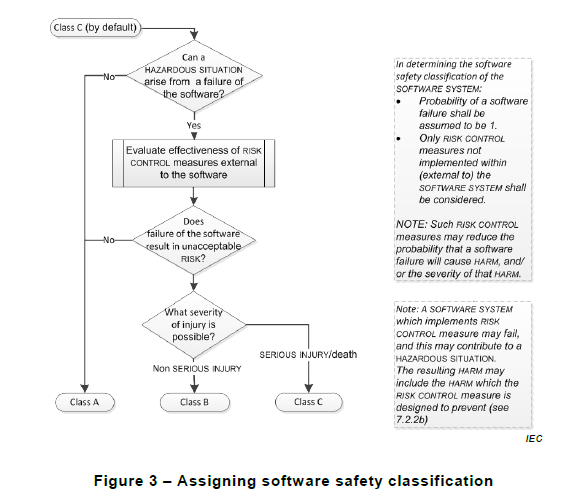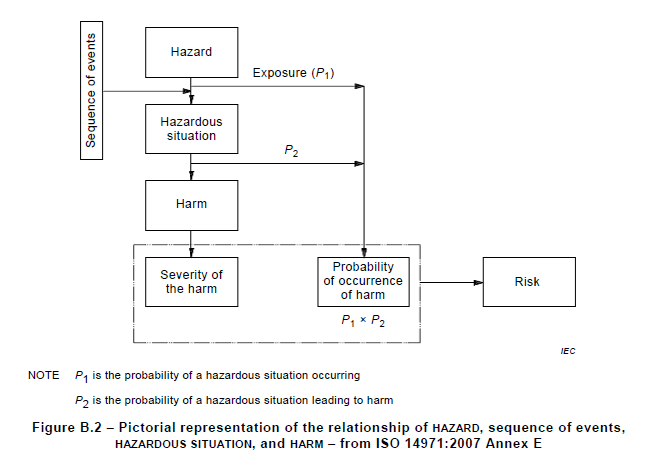How Software Safety Classifications changed in IEC 62304:2015 Amendment 1
The first amendment to the IEC 62304 was released in June 2015 and contains some welcome contributions, including:
- Clarification on the scope of the standard
- Information on how to approach Legacy Software
- Increased number of clauses applicable to Class A
There were also some interesting changes made to Software Safety Classifications in section 4.3.
For those familiar with the original IEC 62304 text, the following section describes to assign a Software Safety Classification:
"The MANUFACTURER shall assign to each SOFTWARE SYSTEM a software safety class (A, B, or C) according to the possible effects on the patient, operator, or other people resulting from a HAZARD (being a potential source of Harm) to which the SOFTWARE SYSTEM can contribute.
The software safety classes shall initially be assigned based on severity as follows:
Class A: No injury or damage to health is possible
Class B: Non-SERIOUS INJURY is possible
Class C: Death or SERIOUS INJURY is possible
If the HAZARD (i.e. the potential source of harm) could arise from a failure of the SOFTWARE SYSTEM to behave as specified, the probability of such failure shall be assumed to be 100 percent."
This is essentially saying that severity alone decides the classification of your software system/item/unit. Since there is no consensus on how to determine the probability of software failure, the probability of a failure to occur is assumed to be 100%, effectively eliminating the probability factor from having any kind of influence on the software safety classification.
Now, software in itself has never killed anyone. When harm occurs due to a software failure, there is always some other executing agent involved, e.g. some piece of hardware or a human actor. Consequentially, for harm to occur, there must exist a causal chain of events, tying the software to the harm via that external agent. A causal chain of events occurs with some probability, sometimes called probability of harm.
Probability of harm did not play any prominent part in the original release of IEC 62304 and focusing by effectually removing the probability of failure from the equation due to the difficulties of establishing it in quantitative terms sometimes lead to more or less absurd results.
In examples where a failure has severe consequences but is extremely unlikely to result in any kind of harm, the software safety class is C according to IEC 62304:2006 (if no hardware mitigations exist), regardless of how unlikely the risk of harm is.
And here is where the authors of the IEC 62304:2015 Amendment 1 have done a great job reformulating the Software Safety Classification section.
The IEC 62304:2015 Amd 1 section 4.3 point a) now reads:
"a) The MANUFACTURER shall assign to each SOFTWARE SYSTEM a software safety class (A, B, or C) according to the RISK of HARM to the patient, operator, or other people resulting from a HAZARDOUS SITUATION to which the SOFTWARE SYSTEM can contribute in a worst-case scenario as indicated in Figure 3.

The SOFTWARE SYSTEM is software safety class A if:
the SOFTWARE SYSTEM cannot contribute to a HAZARDOUS SITUATION; or
the SOFTWARE SYSTEM can contribute to a HAZARDOUS SITUATION which does not result in unacceptable RISK after consideration of RISK CONTROL measures external to the SOFTWARE SYSTEM.
The SOFTWARE SYSTEM is software safety class B if:
the SOFTWARE SYSTEM can contribute to a HAZARDOUS SITUATION which results in unacceptable RISK after consideration of RISK CONTROL measures external to the SOFTWARE SYSTEM and the resulting possible HARM is non-SERIOUS INJURY.
The SOFTWARE SYSTEM is software safety class C if:
– the SOFTWARE SYSTEM can contribute to a HAZARDOUS SITUATION which results in unacceptable RISK after consideration of RISK CONTROL measures external to the SOFTWARE SYSTEM and the resulting possible HARM is death or SERIOUS INJURY.”
The pivotal point lies in the use of the terms "RISK of HARM" and "unacceptable risk". RISK, in this case, being a combination of severity AND probability.
Now, the probability of harm, (the probability that someone gets hurt) is different from the probability of failure (the probability that the software malfunctions).
The combination of these two probabilities becomes the probability of occurrence of harm. IEC 62304:2015 Amd 1, explains this further in section B4.3 and also includes a Figure (B.2) from ISO 14971.

This means that it makes sense to incorporate both the probability of failure and the probability of harm in our risk assessments. We will still stay true to IEC 62304:2006 by setting probability of failure to 1 (100%) (and avoid the problematic discussion of the probability of a software failure) and concentrate our efforts on correctly estimate the probability of harm.
The amendment of the standard also claims clinical knowledge might be necessary to correctly estimate that the probability of harm following a hazardous situation, in order to “distinguish between hazardous situations where clinical practice would be likely to prevent HARM, and hazardous situations that would be more likely to cause HARM.” This certainly makes sense since the casual chain of events leading from a hazardous situation to a harm typically takes place in a clinical context.
There are also further complications. Where it previously was sufficient to map severity to the “no injury”, “non-serious injury”, and “serious injury” categories, which is fairly straightforward, we now have the additional possibility of bringing in the risk's acceptability into the picture.
Establishing severity and probability is one thing that can be done fairly objectively, but in a rational manner argue why a particular combination of these factors is “unacceptable” or “acceptable” is subjective at best, opening the software safety classification establishing to an amount of arbitrariness. On the other hand, "unacceptable" and "acceptable" risks are terms defined in ISO 14971 and should therefore not be new territory to the average medical device manufacturer.
The software safety classification method in IEC 62304:2015 Amendment 1 has certainly become more intuitive. The price for this change lies in the extra effort of:
- Establishing the probability of harm following a hazardous situation, with the involvement of clinical expertise if and where applicable.
- Establish and rationalize what makes a particular risk limit acceptable or unacceptable, if not already defined in the general risk management process.
To finalize this discussion on Software Safety Classification in IEC 62304:2015 Amd. 1, I would like to point out sections in the standard that have received some welcomed clarifications.
Segregation
The new version of the standard amends that segregation of software items does not necessarily have to be physical. In the 2006 version, the only segregation exemplified was hardware-related, which has lead to the false belief that segregation between items has to be physical. This is not the case. The 2015 Amendment makes it clear that the main concern is to assure that one item does not negatively affect another. Furthermore, the segregation applied shall make sense in the context it is used as well as clearly documented and rationalized.
Software Items implementing risk controls
A software item implementing a software risk control (i.e. not external risk controls which can have a positive effect on the classification) shall be assigned the same software safety classification as the software item containing the risk it is controlling. This idea is applicable not only on System level (as described in the 2006 version) but also Item/Unit level.
Learn more about how Aligned Elements can help you support IEC 62304
Request a live demo and let us show you how Aligned Elements can help you to comply to IEC 62304